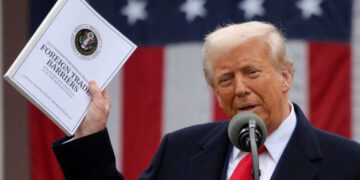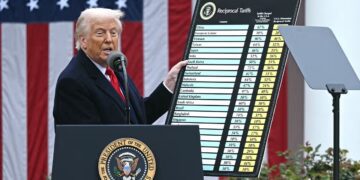By John F. Di Leo -
The trade war between Mainland China and the United States is in the news.
From the business pages to the front pages, day in and day out, there is a focus on the punitive tariffs that the Trump administration placed on Chinese goods on top of our regular import duties, on the retaliatory tariffs that China put on American goods on top of their own regular duties, and on the general toll that this trade war is taking on the American economy.
One might be forgiven for imagining that this argument with China was the only front in the effort to improve America’s economic position… but one would be mistaken.
In truth, while the Trump administration is indeed working hard on the very difficult task of adjusting our commercial relationship with the world’s most populous communist country, the administration really isn’t single-mindedly focused in that direction at all.
While the press devotes coverage to Beijing, the office of the United States Trade Representative, Robert Lighthizer, has its deputy ambassadors working around the clock to break down trade barriers all over the world. For example, just this November alone:
- The USTR announced conclusion of two separate negotiations with South Korea in which the Koreans have committed to crack down on illegal fishing in and around their waters that threatened to deplete the North Pacific’s natural stock of fish and seafood, and in which the Koreans have opened up their import quotas on rice to give American farmers access to 132,304 tons of rice export opportunities per year, at a value of about $110 million.
- The USTR finally succeeded in getting Brazil to open up their duty-free wheat import quotas, enabling American farmers to compete on a level playing field for this 750,000 ton opportunity with the most populous country in South America.
- The USA won its case before the World Trade Organization (WTO) to declare India in violation of the WTO’s bans on certain types of export subsidies. As a form of dumping, such programs cause products to be exported at a lower price than competitors in other countries can offer. Enforcing such WTO bans helps not only US exporters but all traders who desire to compete on the world marketplace on a level playing field.
- The USTR announced success in getting Mainland China to lift its ban on U.S. poultry that China put in place during the Obama administration. This alone will enable approximately a billion dollars worth of annual sales of American poultry to China… and that’s independent of the China tariff and intellectual property challenges that have been dominating the headlines for the past two years.
And that’s just in the last few weeks!
Simultaneously, various deputies in the administration have been meeting with other countries, large and small, from Rwanda to New Zealand, from Asia to Europe, working to bring down non-tariff trade barriers and laying groundwork for more robust agreements.
The U.S. government doesn’t grow the crops, manufacture the machinery, or run the export companies, as the governments of command economies like China and Russia might. In our system, these are the roles of the farmer, the commodities trader and the manufacturers and distributors of our private sector.
But with so many other countries setting up walls against trade, it is our government’s role to help break down those obstacles so that our private sector can indeed compete, and offer our products for sale on an even playing field.
Tariffs and Non-Tariff Barriers
Our media coverage has understandably focused on the escalation of punitive tariffs that President Trump has placed on Chinese goods in his effort to open up China’s market for American exports… but such tariffs are far from the whole story in international trade.
Most imported products have always been subject to import duties, usually ranging from a few percent of the sale price of the goods (such ad valorum tariffs are the most common) up to ten or twenty percent or even more. A primary goal of the WTO since its inception has been to drive these standard duty rates down, so that the more protectionist countries that used to charge thirty, forty, even fifty percent import tariffs would now charge rates more in line with the rest of us. A worthy effort.
Unfortunately, the policy wonks who set up the WTO, in their dreams of a “level playing field” in world trade, didn’t fully allow for human nature.
Protectionist countries such as India, China and Brazil aren’t going to stop being protectionist just because some global bureaucracy like the WTO says they should. So, when the WTO forced these countries to lower their average import duty rates, they just responded by raising other barriers that are often even more insurmountable. For example:
- Countries can establish import quotas, in which they simply shut the door to further imports every year after a certain level of goods have been imported. Such quotas sometimes fill up in the very first month of the year!
- Countries can subsidize their own exports through tax credit and rebate schemes, so that they gain foreign marketshare unfairly.
- Countries can set complex testing-and-approval methods for foreign products, so that foreign companies have to spend thousands of dollars per product SKU just to obtain government authorization for their importers to consider their products.
- Countries can even set obnoxious documentation rules in place at the point of importation, enabling their Customs ministries to slow-walk or deny import clearance, in the knowledge that burdensome Customs inspections, port demurrage charges, and the nickel-and-diming of a host of unanticipated import fees will eventually dissuade their own importers from buying foreign goods.
The list of potential barriers to entry is endless, as it’s more a matter of intent than a fixed target. As long as a country wants to be protectionist, it can dream up new barriers to foreign goods. And that means that a trading partner like the United States must be ever-vigilant, with a trade office that works constantly to bring down these barriers wherever they may arise.
Some of these barriers make the news regularly – currency exchange rate manipulation and intellectual property theft being the kinds of issues that the reporters can understand well enough to write and speak about. But others never make the news, perhaps because if you haven’t worked in international trade, it’s harder to recognize the negative impact that Customs holdups, country-specific product registration requirements and such can have on a business.
All administrations do participate in the WTO dispute process; it’s not like the Trump administration was the first to enter such negotiations. But there is no doubt that the Trump administration has generally been more vigorous on all these fronts than prior American administrations were.
The last few presidencies, both Republican and Democrat, were more focused on setting up free trade agreements (FTAs) which provide reciprocal duty-free benefits to qualifying goods shipped between the member agreements. We now have twenty such reciprocal partnerships… but one could argue that the beneficial focus on those agreements may have come at the expense of needed attentiveness to the other 180 countries on earth.
While this administration has worked on FTAs too – negotiating improvements to the Korea-US FTA, negotiating a complete replacement for NAFTA (which Congress still hasn’t taken up, at this writing) – this administration has had a laser focus on international trade in general, attempting to break down the multitude of barriers to entry that hamstring our export community all over the world.
This isn’t exciting stuff. Opening up some foreign country’s import quota on wheat or rice doesn’t sell newspapers or drive viewership for a cable news program. But it makes a real difference to the men and women who work in American agriculture and industry, from the manufacturing and production arena to the service sectors that support it.
The Trump administration’s focus on breaking down these foreign barriers is the kind of achievement that a future president won’t undo with an executive order. They don’t make the news outside the narrow trade journals for their respective sectors, but they are worthy of note.
Mr. Lighthizer, along with the Trump administration as a whole, deserve some credit for seeing the big picture on international trade. Contrary to what we see on the news, it’s not all about one country’s tariffs alone, and it’s good to have an administration in Washington for once that recognizes that fact.
Copyright 2019 John F. Di Leo
John F. Di Leo is a Chicagoland-based international trade compliance trainer and transportation manager, actor and writer. His columns are regularly found in Illinois Review.
Don’t miss an article! Use the tool in the margin to register for Illinois Review’s free email notification service, so you always know when Illinois Review publishes new content!







